Shoes have been around for as long as man can remember (history says 8000 BC). First they were worn out of necessity to shield one’s feet from harm and to make it easier to move from one place to another. But, we can all admit that the use of shoes has morphed into something more. These days, shoes are not only a necessity but also a luxury, depending on what you’re looking for. Every generation has produced all sorts of shoe designs, and with the advancements that humanity has made in technology, the footwear department was not left behind. Check out these innovative shoe designs made possible by ever-advancing technology.
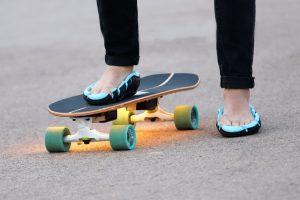
Olga Kravchenko & Yehuda Azoulay is a shoe that has no shoelaces, straps, or even an upper cover. It’s literally a sole that ‘snaps to your feet’! Link presents a very unique approach to footwear. Just step into the soles and they automatically hug your feet, securing themselves in place. Without any upper cladding, the Link feels quite like walking barefoot. They allow your feet to remain ventilated, and providing all the freedom of movement and security you’d get from a pair of sneakers, but with the airy feel of flip-flops. Designed like a massive bumper-case for your feet, the Link is made with an EVA insole that provides the comfort and the grip, and a hard TPU outsole that comes with a fragmented design, allowing it to bend and flex with your feet. Together, the two materials make up Link’s construction, giving it flexibility, openness, friction/grip, and even a protective bumper around your feet, preventing your toes from accidental stubs and bumps.
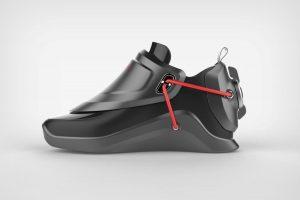
Carota Design’s Nike self-lacing sneaker concepts literally look like they’re from the future. With hard-shell components and gloss/matte finish contrasts, they don’t look or feel like traditional shoes at all, aside from the familiar silhouette, which definitely is a good thing. Designed to highlight the futuristic aspect of shoes that secure themselves, the conceptual sneakers come with a red lace that stands well against the black sneakers. The laces travel from the outsole to the front, and then to the heel, where they connect to a motor that’s triggered by a button. Tap against the button and the motor tightens the laces up, securing the shoe in place. Tap a second time and the laces loosen, allowing you to slip your shoe out! A textbook ‘shut up and take my money’ product!
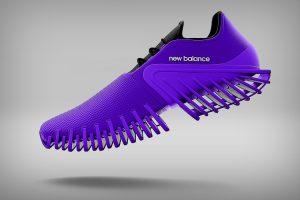
Using 3D printing, Ausin’s New Balace Study aims at redesigning fencing shoes keeping varying usage in mind. The result is two shoes that look a part of the same family, but you can immediately notice how the soles of both feet are completely different, molded by the areas of the feet that feel the most pressure during the lunge forward. Imagine this design philosophy for differently designed footwear carrying forward to other sports like bowling or golf!
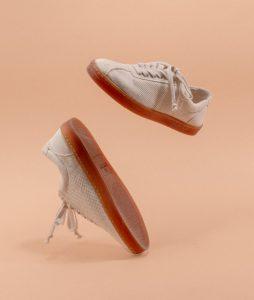
The Plant Shoe by Mike Belgue (Native Shoes) doesn’t use new materials, but rather introduces old materials into a new, one-of-a-kind product. Each part of the shoe is plant-based, using materials like jute, pineapple husk, kenaf, linen, treated with natural oils like olive oil for suppleness and comfort. Tricky bits of the shoe’s design involved finding a workaround for the sole, which Native managed to solve by partnering with France-based Reltex to create a sole that comprises a eucalyptus-pulp insole, kenaf (hemp) and corn cushioning, and a sap-based tread that gives the shoes its grip. Binding all the shoe’s parts together formed the next challenge, as most shoe companies rely on toxic, non-biodegradable petrochemical-based glues to hold the sneaker’s parts together. Native’s solution involved stitching all the parts together using entirely plant-based threads that are strong enough for sneaker construction.
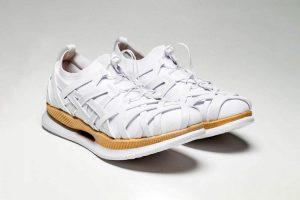
Teaming up with the renowned Japanese Architect Kengo Kuma, ASICS has unveiled the latest edition of the Metaride, an all-white running shoe with a pattern inspired by Japanese Yatara bamboo-weaving, on the shoe’s body. The fabric strips wrap themselves in a seemingly chaotic way, but in fact, are strategically placed to hold the foot steady by binding with the shoe’s innovative Flytefoam base that uses cellulose nanofiber, a strong and lightweight wood-pulp derived material currently being researched and explored in Japan. The shoe is described as ‘moving architecture’ by Kuma, who relied on the age-old technique of Yatara to provide aesthetic dynamism as well as a comfortable fit.
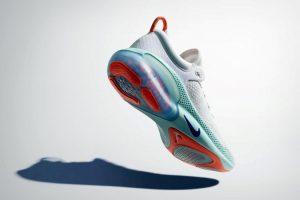
Designed for bespoke comfort, and for unparalleled lightness while running, Nike’s Joyride Run Flyknit literally has a sole that’s filled with multiple tiny squishy spongy beads. Resembling a beanbag for your feet, the Joyride give your feet the same feeling a beanbag gives your body. A cushioned experience that takes the shape of your foot. Engineered to perfection, these beads have absolutely the perfect density, allowing you to run on any surface without feeling the stress on your heels, shins, or knees. Made from thermoplastic polyurethane or TPE, the beads are size-calibrated and placed exactly at crucial areas of the sole so as to expand in all directions when you land your feet on the floor, cushioning impact and letting you literally feel like you’re running on a bed of memory foam, or if you’re looking for a more poetic comparison – ‘running on air’.

Kids grow fast, which means they outgrow their clothes and shoes rapidly too… forcing low-income-family children to either wear shoes even after they stop fitting, or walk around barefoot. On a mission to make one shoe that lasts through this growth process, Kenton launched The Shoe That Grows, an innovative piece of footwear that expands to fit children as they grow with age. Ill-fitted shoes are uncomfortable, but walking barefoot leaves children vulnerable to soil-transmitted diseases and parasites that can cause illness and even death, aside from the cuts, burns, and blisters. The Shoe That Grows combats the unfortunate scenario where children outgrow their footwear by being the one pair of footwear that grows with them. Extending at the front, sides, and the back, the sandals work simply like a belt would, expanding with size and necessity.
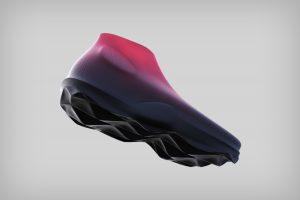
The 3D Surprise shoe by Dewayne Dale was created as a result of conceptualizing directly in 3D CAD software, rather than sketching first and building later. The conceptual shoe features a unibody design with a subtle gradient from top to bottom, visually creating a separation between shoe and outsole, while there’s no surface break between the two. Harnessing the shape of the foot, building on the bones and muscles within, the 3D Surprise was envisioned as a new-age hiking boot with a design that was simple and sophisticated looking. The shoe comes with an exaggerated protrusion detail for the ankle bone, and a textured sole that looks industrial and organic at the same time.
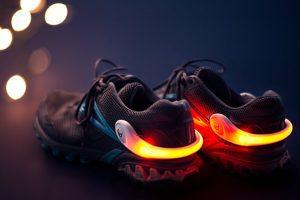
Made to bend around your heel and fit onto any shoe of any size, the Spurz by 4id come in a wide variety of colors and can be configured to either flash a steady light or blink continuously. With a run time of 70 hours when on steady light and 100 when blinking, the Spurz will need a battery replacement probably once every 3 months. They’re even designed to be absolutely weatherproof, so whether you’re out in the sun, rain, snow, you know you’re visible, and literally ‘marked’ safe!
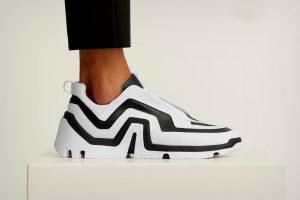
Pierre Hardy’s Vibe Sneakers are a perfect embodiment of that stormtrooper aesthetic, with its jagged zebra-esque design that gives the shoes heavy dynamism and contrast, making them absolutely eye-catching and jaw-dropping. Built with a gum sole and a calf-leather upper, the Vibe sneakers from Pierre Hardy are luxury and style wrapped in a singular package. Creating an edgy contrast with the racy geometric stripes, the Vibe’s patterns actually draw inspiration from sound waves, which are translated onto the shoe’s body by pairing leather cuts all the way from the bottom to the very top.
Source: [AFP]
